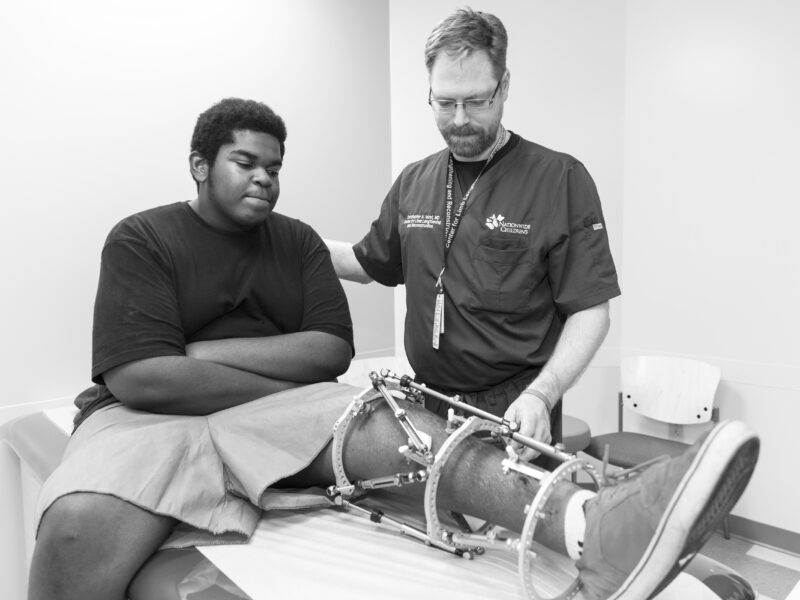Determining the Probability of a Sequential Slipped Hip
Determining the Probability of a Sequential Slipped Hip https://pediatricsnationwide.org/wp-content/uploads/2021/01/110612ds566-1024x683.jpg 1024 683 Mary Bates, PhD Mary Bates, PhD https://secure.gravatar.com/avatar/c6233ca2b7754ab7c4c820e14eb518c8?s=96&d=mm&r=g- January 26, 2021
- Mary Bates, PhD

A new predictive tool offers an objective method to help guide treatment in patients with unilateral slipped capital femoral epiphysis.
In a recent study, researchers at Nationwide Children’s developed a scoring system based on radiological findings to predict sequential hip involvement in patients with unilateral slipped capital femoral epiphysis. They hope this predictive tool will help identify which patients should have their asymptomatic hips prophylactically treated at the time of presentation.
Slipped capital femoral epiphysis (SCFE) is a common hip disorder in adolescents and growing children. Without early detection and proper treatment, it can lead to potentially serious complications, including painful arthritis.
Kevin Klingele, MD, chief of orthopedic surgery at Nationwide Children’s, director of the Center for Hip Preservation, and senior author of the new study, says a challenge in treating children who present with a SCFE on one hip is determining the risk of a sequential SCFE on the other hip.
“A prophylactic screw fixation could prevent slipping in the future but the procedure is not without risk, he says. “We don’t want to operate on a hip that will remain normal. The idea behind this study was to develop a predictive tool to help guide treatment of these patients.”
Dr. Klingele and his colleagues used three radiographic parameters to develop a PASS (Probability Analysis of Sequential SCFE) score for the asymptomatic hip at the time of presentation for the involved hip. The researchers say PASS score calculation can be used to predict a sequential SCFE and provide an objective method to determine which patients might benefit from prophylactic screw fixation.
A PASS score of three or higher — suggesting a 28% or higher probability of sequential SCFE — indicates that treatment of the asymptomatic hip is warranted.
According to Dr. Klingele, PASS scores have changed how indications for prophylactic screw fixation are created at Nationwide Children’s.
“In the past, we have used MRI of the contralateral hip to judge if kids show signs of pre-slip, however the usefulness of this approach has not held up with further study” says Dr. Klingele, who is also adjunct assistant professor of Orthopedic Surgery at The Ohio State University College of Medicine. “Availability, cost and the reliability of MRI limit its use as a screening tool. These are simple x-ray measurements that give us more accurate probability numbers.”
Dr. Klingele and his colleagues plan to assign PASS scores to all incoming unilateral SCFEs at Nationwide Children’s, in addition to applying this scoring system to patients at collaborating centers.
“We would like to retrospectively apply PASS scores to other populations of SCFE patients in other hospital systems to see how often sequential slips could have been prevented by the use of this tool,” he says.
“Anywhere from 20 to 60% of kids with a SCFE on one hip will ultimately develop a sequential SCFE on the other hip. PASS scores can help identify those kids whom we should treat prophylactically to prevent hip deformity.”
Reference:
Danino B, Singh S, Shi J, Yang J, Samora WP, Iobst CA, Klingele KE. Probability analysis of sequential SCFE (PASS score). Journal of Child Orthopedics. 2020 Oct 1;14(5):387-396. doi: 10.1302/1863-2548.14.200080.
Image credit: Nationwide Children’s
About the author
Mary a freelance science writer and blogger based in Boston. Her favorite topics include biology, psychology, neuroscience, ecology, and animal behavior. She has a BA in Biology-Psychology with a minor in English from Skidmore College in Saratoga Springs, NY, and a PhD from Brown University, where she researched bat echolocation and bullfrog chorusing.
-
Mary Bates, PhDhttps://pediatricsnationwide.org/author/mary-bates-phd/December 27, 2016
-
Mary Bates, PhDhttps://pediatricsnationwide.org/author/mary-bates-phd/
-
Mary Bates, PhDhttps://pediatricsnationwide.org/author/mary-bates-phd/
-
Mary Bates, PhDhttps://pediatricsnationwide.org/author/mary-bates-phd/
- Post Tags:
- Orthopedics
- Posted In:
- In Brief






